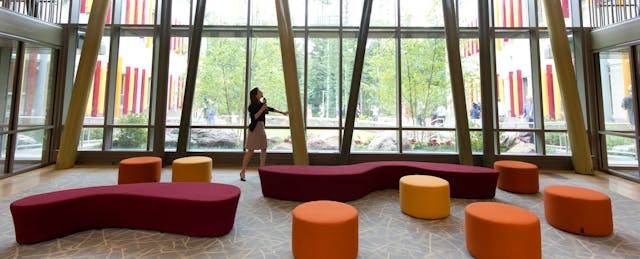Last Friday I found myself sitting in a bright sunlit room in Washington D.C. On my left was the Superintendent of Schools from Newtown, Conn., and next to him, the new principal of the new Sandy Hook Elementary School. On my right sat two high school students, survivors of the massacre at Margery Stoneman Douglas High School.
I had been uncomfortable at this event before I sat down in that spot, but once I found myself at this epicenter of pain and loss I realized that I did have a purpose that day.
Children are why we build a society. Children are the reason we want to build a just society, an equitable society, an embracing culture. Children are why we want a clean and healthy environment, why we want communities that are both safe and open, and both unified and diverse.
As our group began to speak, I watched closely as Joe Erardi, the recently retired superintendent of Connecticut’s Newtown Public Schools described his mission as he led the building of the new Sandy Hook Elementary, “I wanted a beautiful place,” he said. “I wanted a beautiful place that children would love.”
I introduced myself this way: “I’ve spent the last ten years tearing down walls within school buildings and adding doors to the outside,” I began, somewhat countering earlier narratives of the morning, “and I am absolutely certain that this has not only made our schools safer, but has created great learning spaces that create great experiences for kids.” Then I paused, and assured them that, “I’m not naive, I’ve been a New York City Police Officer, I’ve seen a world of violence, and,” in a nod to the fire expert who sat across the table from me, “I went to a huge high school that burned to the ground.” “But I believe we’ve taken the right path.”
I think that we usually miss the point when we say, “we’re going to build a school.” Yes, it is about the physical building, but that is just one part of the big equation.
In Washington on Friday we gathered to talk about safe schools in a summit organized by the AIA Committee on Architecture for Education (#aiacae), a group I’ve been thrilled to be part of over the last year or so. The committee called together a wide-ranging group—educators and architects, school psychologists and law enforcement, code officials and school hardware specialists, and the kids from Parkland, Fla.—all looking to create a broad definition of what a “safe school” is, and to build a framework of principles that might start to add definition to that goal.
It was a good day, but at the wrap up, I felt compelled to bring up the question I keep asking these days. “I really ask all the architects here,” I said in response to an architect who had asked educators to be better clients—with bigger dreams— “to help develop those better clients by asking, at the very start, What do you want your children to be? Don’t ask about spaces or number of students or timelines or budget, not yet. Make that first question, What do you want your children to be? and help us remake education.”
What Do You Want Your Children to Be?
It is that question that needs to define everything about what a school is. If you want your children to be creative, to be collaborators, to be great communicators, to know how to make choices, to know how to build their own work and/or learning environments, to be kind, to be curious, to learn throughout their lives from the great wide world, to engage with technology well, to build healthy relationships and lead healthy lives then can you really do that within the closed boundaries of traditional schools? Can you do that with age-separated learning? With closed classroom doors? With separated subject areas? Without seating choices? Without technology choices? Without culturally engaged learning groups?
Can you do that with bells ringing telling kids to stop what they are thinking about and move on to another subject? Can you do that when you artificially divide kids, whether via reading “levels,” or with honor rolls, or with one or two student activities honored above the rest?
What—from space, to rules, to time schedules, to how and where lunch is eaten, to what voice a teacher uses, to where the teacher desk is, or if there is a teacher desk, to homework attitudes, to whether kids can personalize computers—creates the school that is most likely to yield the learning our kids need?

Don’t Limit Yourself
I know a principal who put her desk in the central corridor intersection of her middle school. Another ended her elementary school teachers’ use of window sills as storage—instead they became places for kids to sit, to read, to work. One encouraged her kids to transform their cafeteria by building massive rolling tree houses. A high school principal turned little-used hallway locker areas into student hangout/breakout spaces. Others embraced the notion of multiage—K-5 together— learning environments. In another high school ninth and tenth graders learn in a cross-curricular group with four teachers and no bell schedule. Elementary schools, big and urban, tiny and mountain rural, have abandoned single teacher classrooms completely.
Those are just examples, there are thousands of leaders taking big risks every day. But we need to make that risk-taking systemic. We need to take the re-invention of education seriously. We need to mean it when we say “we’re going to build a new school,” or, “we’re going to rebuild an old school,” so that we imagine into existence something completely new—and thus give our architects free range to develop true child-centric learning spaces.
We need to do this because, if we truly value our children, we will offer them the very best that we can—even if that is very hard, even if we need to transcend many obstacles, even if a city or county or state government wants to fight us. We need to do this because our kids are looking at us, every day, and wondering, “Why don’t we care enough?”
And then we need to stand up for what is right for children. We need to fund schools well, fund early childhood programs well, make sure that parents can afford to spend time with their kids, make sure that every family has access to health care, decent housing, enough food, make sure that mental health care—in school and out—carries no stigma. And we need to get military-grade weapons out of the hands of civilians.
Putting Kids First
Our education system was built from the very beginning on adult needs and adult priorities. Whether it was Jefferson’s goal: “By this means twenty of the best geniuses will be raked from the rubbish annually, and be instructed at the public expense;” or Woodrow Wilson’s goal, “ We want one class of persons to have a liberal education, and we want another class of persons, a very much larger class, of necessity… to forego the privileges of a liberal education and fit themselves to perform specific difficult manual tasks…They must make a selection, and you must make a selection…;” or Ellwood Cubberly’s goal: [schools need to be] “factories in which the raw materials (children) are to be shaped and fashioned into products to meet the various demands of life. The specifications for manufacturing come from the demands of twentieth century civilization, and it is the business of the school to build its pupils according to the specifications laid down;” or even the Eisenhower administration’s goal—an education modeled after the post-Stalin Soviet Union.
But what might school look like if we were helping kids to build their future society, a better society, a better world? If that was our goal would we do anything that we do now? Would we build boxes around kids, around curricula, around age groups, around time? Would we design a secondary school without observing and asking current five-year-olds? Would we make it difficult to go outside? Would we make sitting still a virtue? Would we accept the idea that we would prefer to “harden” learning spaces for children rather than take away weapons designed for only one task—murder?
We need to be grateful that the AIA-CAE crafted a meeting focusing on hope, not fear—and for the effort to fight against knee-jerk security reactions and for solutions that represent real goals for kids. Yet I’ll quote one Margery Stoneman Douglas alumnus, who asked, “If we’re talking about schools, shouldn’t kids have outnumbered adults?” Yes, we need to remember who brings the most relevant voices.
In the end, one moment made my day. Walking with two Parkland, Florida girls, I told them of their influence and impact on Virginia kids, and I asked them to keep fighting, no matter how disappointing American adults seemed to be. “Listen,” I said, “the old folks are dying off, and then you’ll be able to make things right.” I’m sure that’s not the kind of thing most adults tell them, but it’s as true as it is “inappropriate.” And hearing my thought they burst into laughter—real teenage kid laughter—as one said, “that’s my quote for the day.” And in that laughter I heard what was important.
A high school principal I once knew always referred to his students as “children.” When asked why, he said, “My children don’t get to be children at home. They work to feed their families, they care for younger kids, they need to be adults out there. So when they come here I want them to be able to be children.”
When we build a school, or rebuild a school, we need to insist on doing the right thing, and doing it completely. We must create a learning space that is physically safe, psychologically safe, emotionally safe for every child. And that learning space needs to be surrounded by a community, a nation, and a state with that same abundance. Only then can our kids truly be kids, and truly be kids on their way to being healthy adults. Adults who will be way better than we adults have been.
Do not say it is too hard. Do not say we don’t have the energy, the resources, the time. We have all that in more if we think its important.
And it is important. Because we should never have to be in a room with kids and discuss “hardening" a school. We should never have to discuss ‘bulletproof’ glass for schools. We should never need to talk about “lockdowns” and “active shooter drills.”
We have done so little, and we owe the future so much more.


